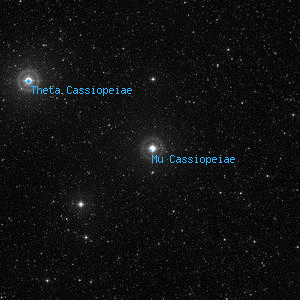Mu Cassiopeiae

Overlaid DSS image of Mu Cassiopeiae, 60' x 60' with north at top and west to the right
Aladin viewer for the region around Mu Cassiopeiae
μ Cas, 30 Cas
BD+54 223, HD 6582, HR 321, WDS J01083+5455A, SAO 22024, HIP 5336
BD+54 223, HD 6582, HR 321, WDS J01083+5455A, SAO 22024, HIP 5336
| Type | Star |
|---|---|
| Magnitude | 5.1 | Right Ascension | 1h 8' 16.4" (2000) |
| Declination | 54° 55' 13" N |
| Constellation | Cassiopeia |
| Classification | G5Vb |
Observing Notes
Captain William Henry Smyth
Nov 18, 1835 No. 6 The Crescent, Bedford, England (map)
150mm f/17.6 refractor by Tully 1827
A coarse triple star in the Lady's right elbow, whence, conjointly with θ, the Arabians termed it Marfak. A 5½, deep yellow; B 14, pale blue, with a minute comes sf; and C 11, bluish. There are several small stars in the field, and I was assured by an astronomical friend that one existed very close to A; but, on reference, both Mr. Chain's with the Northumberland telescope, and Mr. Dawes with an eight-inch object glass, make a diagram similar to my own. My friend therefore must have been mistaken.
This star is in the British Catalogue; but Mr. Baily says he cannot find a perfect observation of it by Flamsteed. It has, however, so rapid a course through space, that it should be constantly watched, as its displacement by proper motion is the largest yet detected among stars not closely double, and having no obvious peculiarity. This is a statement of the several values :P.... RA +5".70 Dec. -l".6oNow, supposing this star to be about the same distance from the earth as analogy assigns to its magnitude, its hourly motion cannot be less than 125,000 miles, under the operation of forces incomprehensible to the human mind. Indeed, even from this remote speck, its consequences are observable ; for this wonderful movement of A leads it in a course which forms an angle of 107° from its present vertical; so that in about six years B unless participating in its journey through space will become due south of A, telescopically speaking.
B.... +5".82 -1".55
A.... +5".80 -l".55
[Gaia DR2 +3".422 -1".598]
[This companion star is listed as WDS J01083+5455B or GSC 03673-00194 with a V magnitude of 10.5. As Smyth surmises, the high proper motion of μ Cas has left the star behind such that it lies over 8' west in 2020]
Just 18' south of μ, is a star which, though of the 6th magnitude, is not in Piazzi. It is followed nearly on the parallel, about 11s off, by a 9th magnitude, and both are remarkable from being red, of a decided but not deep tint. This object may have had something to do with the mistakes of Flamsteed respecting μ, alluded to by Mr. Baily.
[18' southeast of μ Cas is HD 6833, a 6.7 magnitude K0 orange giant. This would have been closer to 26' SE in 1832, not 18' south, but it is the only 6th magnitude star in the area of μ Cas. For the 9th magnitude Smyth mentions? There is no obvious candidate star in the described place, or anywhere in the region south of μ Cas]
To find this star by alignment, draw a line from β through α, and extend it as far again as the distance between those two, and μ will be seen just above, with θ following it.― A Cycle of Celestial Objects Vol II, The Bedford Catalogue, William Henry Smyth, 1844
Other Data Sources for Mu Cassiopeiae
Nearby objects for Mu Cassiopeiae
1 object found within 120'
| Theta Cassiopeiae |
Credits...
Drawings, descriptions, and CCD photos are copyright Andrew Cooper unless otherwise noted, no usage without permission.
A complete list of credits and sources can be found on the about page
Mu Cassiopeiae